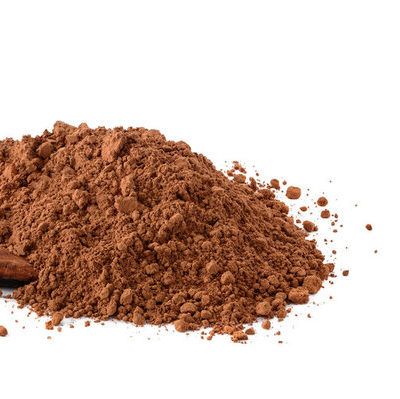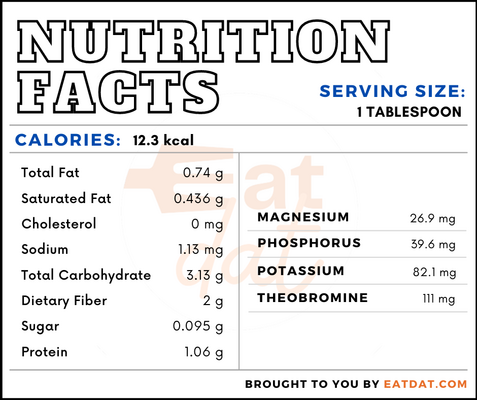
Cocoa Powder
What is Cocoa Powder?
Cocoa powder is a product made from cocoa beans obtained from the cacao tree. The beans are roasted, shelled, and ground into a liquid, separating the cocoa butter from the solids. Cocoa powder refers to these solids in which a small proportion of cocoa butter remains. Authentic cocoa powder is brown in color and has a bitter but rich taste.
- There are three varieties of cocoa powder: brute, natural cocoa and Dutch process cocoa.
- Cocoa powder is used to prepare chocolate, desserts, and drinks, like hot chocolate.
The top 8 most popular cocoa powder brands are:
- Hershey’s
- Barry
- Divine
- Navitas Organics
- Rodelle
- Ghirardelli
- Valrhona
- Chatfield’s
Origin of cocoa powder
Cocoa was a staple diet of the ancient Olmecs of South America. There is archaeological evidence that these civilizations cultivated the crop at least as far back as 1500 BC. It was considered a sacred drink and was extensively used in religious ceremonies. The Aztecs and the Mayas followed suit and chocolate became a staple drink in this region. During the Aztec period, cacao beans were used as currency. Also, they held a reputation as an aphrodisiac.
Cocoa powder was consumed as a spiced drink at this time until the arrival of the Spanish. Hernán Cortés is often credited with making cacao popular in Europe. However, alternative theories credit Christopher Columbus. A third story claims that some friars presented cacao beans and Maya slaves to Philip II. Later on, cacao spread through colonization to other parts of the world. The invention of the Dutch process cocoa made by Coenraad Johannes van Houten made this luxury available to all types of people. Today, chocolate is a delicacy that everyone can enjoy.
Nutrition
Nutritional profile for unsweetened cocoa powder (1 tbsp):

In addition, cocoa powder also contains micronutrients such as calcium and iron. Also, it contains selenium, folate, choline, and lutein.
Cocoa powder and chocolate are very rich in phenolic compounds, especially when compared to any other food. Flavonoids such as catechin, epicatechin, and procyanidins induce antioxidant activity, providing beneficial health effects. Regular consumption of cocoa powder may help in boosting heart health, reducing cardiovascular diseases and diabetes, increasing immune response, protecting nerves from inflammation and injury, aiding skin health, as well as working as a mood enhancer. Additionally, it has the ability to help prevent cancer due to its ability to prevent oxidative stress.
Commercial production
There are many different varieties of cocoa, the main ones being forastero, criollo, and trinitario. The main cocoa bean producing countries are Côte d’Ivoire, Ghana, Indonesia, Nigeria, Cameroon, Brazil, Ecuador, Peru, Dominican Republic, and Colombia. Côte d’Ivoire accounts for 30 percent of the world’s cocoa production.
First, after being plucked, wet cacao beans are left to ferment and dry. Then, they are cleaned and shelled. Next, the kernels, known as cocoa nibs, are roasted and ground into a liquid cocoa mass. During this process, the kernels may be alkalized in a process known as Dutch process, which changes the color and taste of the cocoa. After that, the fats are pressed out of the cocoa mass to get cocoa butter and dry cocoa solids. The latter is cocoa powder in which some cocoa butter may be left.
It is best to store cocoa powder in an airtight container and keep it in a cool and dry place to prevent moisture and heat from affecting it. Storing this product in the fridge must be avoided in order to prevent moisture.
Cocoa powder recipes
Cocoa powder is extensively used in making chocolates. Apart from this, it is also bought unsweetened to prepare desserts, drinks, or liqueurs such as Crème de Cacao. Here are a few recipes to try:
- Brownies
- Chocolat Chaud
- Dark Chocolate Truffles
- Chocolate Walnut Bars
- Chocolate Tart
- Viennese Cookies
- Sachertorte
- Chocolate Babka
- Manjarblanco de Chocolate
- Chocolate Alfajores
- Demerara Brownies
- Chocolate Puff Puff
- Coconut Clusters
- West African Hot Chocolate
- Xocolatl
FDA regulations
The FDA uses the term ‘breakfast cocoa’ for cocoa powder, which is defined as the food prepared by pulverizing the material remaining after part of the cacao fat has been removed from ground cacao nibs. Also, the definition stipulates that it must contain at least 22 percent cacao fats.
References
Mark Gibson, Pat Newsham, Chapter 17 – Chocolate/Cacao, Editor(s): Mark Gibson, Pat Newsham, Food Science and the Culinary Arts, Academic Press, 2018, Pages 341-352, ISBN 9780128118160, https://doi.org/10.1016/B978-0-12-811816-0.00017-8., https://www.sciencedirect.com/science/article/pii/B9780128118160000178
Cocoa Story: The production process – from cocoa beans to semi finished products, European Cocoa Association (ECA)
https://www.eurococoa.com/en/cocoa-story/cocoa-story-the-production-process-from-cocoa-beans-to-semi-finished-products/
History of Chocolate, History Magazine, https://www.history.com/topics/ancient-americas/history-of-chocolate
Katz, David L et al. “Cocoa and chocolate in human health and disease.” Antioxidants & redox signaling vol. 15,10 (2011): 2779-811. doi:10.1089/ars.2010.3697
https://www.ncbi.nlm.nih.gov/pmc/articles/PMC4696435/
